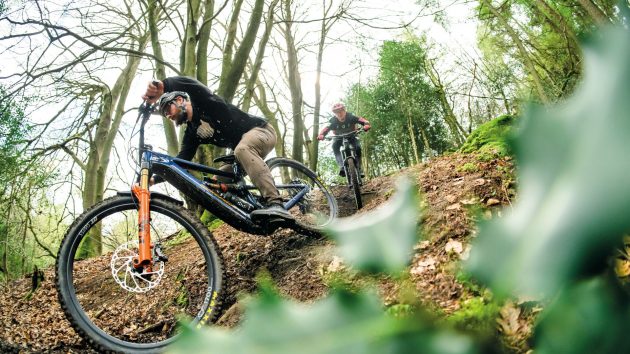With great power comes great responsibility
UK riders could get access to double the average power output from e-bikes, with throttle controlled motors also on the table, after the department of transport launched a consultation on their use. At present 250w of average power is the most any e-bike can legally pump out, but ministers will soon debate upping that to 500w. How the power is controlled is also up for grabs, with grip-shift controls potentially becoming legal alongside the traditional pedal-assisted approach.

The SRAM Powertrain motor is capable of 680w of peak power, meaning any change in the law will be largely irrelevant to off-road use
And it’s the throttle-power idea that’s really the problem here, because no one seems to have noticed that e-bikes currently deliver far more than 250w of power. Take a quick trawl through some of the best electric mountain bikes out there and everyone from BMC to YT makes a bike with at least double that already, with SRAM’s new Powertrain leading the field at 680w of peak power. Heck, even the SL crew peak at over the 320w, in the case of Specialized.
The point here is that we’re talking about peak power, of course, which is not currently limited by law, while a motor must not run steadily above 250w. That means any changes to the law won’t really be felt by mountain bikers because motor manufacturers have already overcome this puny power limit.
What’s really scary though is the idea we could soon see throttle-powered e-bikes charging around the streets and indeed down the trails. It’s one thing to match a bike’s power to your own leg work, as is currently the case, and quite another to let potentially inexperienced riders get instant access to huge power at the flick of a wrist. Maybe I’m in danger of being an old git here, but pedalling on the power naturally controls and meters it out, while dumping it on via throttle is just too darned easy.
The dramatically increased power would mean faster acceleration and much heavier bikes, which we’re really concerned about
And we’re not the only ones that think so, Cycling UK reckons the idea is unsafe and unnecessary. “The dramatically increased power would mean faster acceleration and much heavier bikes, which we’re really concerned about,” Sarah McMonagle from Cycling UK says in response to the consultation.

E-bikes don’t come cheap, but the Vitus E-Mythique LT VRX bucked the trend… get it while you still can
It’s not a lack of power that discourages people from riding their bikes, she says, but rather the lack of safety and expense of buying an e-bike that puts them off. Safety is almost certainly a factor when riding in the city, but the price of e-bikes is certainly one of the main stumbling blocks for mountain bikes. The best budget electric mountain bikes still cost north of £3,000, and you’d better get in there soon as deals on the likes of Vitus and Nukeproof aren’t going to be around much longer after the soon-demise of Wiggle.
Meanwhile, I very much doubt changing the law in the UK would prompt a flood of higher average power e-bikes either. Motor and bike manufacturers build their products for global markets, and the idea they would specifically engineer a high-power product for the UK is unlikely. Much more probably is we’d get the same EU-approved bikes that are restricted to 250w. It works the other way round too, bike brands based in the UK build their wares to EU regulations because they need to sell into that market.

Fast is fun on an e-bike, so adding another 20mph to the motor’s cut-off point would be welcome… but I should be careful what I wish for
What’s really missing from the consultation though, is a debate about the top speed allowed by an e-bike before the motor cuts out, something that’s not being discussed. At present the motor must cut out at 15.5mph (25km/h), which is far too low for road bikes to make use of and potentially explains the lack of traction in that discipline. Back on the dirt though, I for one would appreciate a motor that doesn’t cut out at 15.5mph and took me on to the heady heights of 20mph that US riders currently enjoy.
However, I’m aware there are some serious problems in hoping for more speed here. Currently there’s no need for bike insurance, no legislation demanding registration of e-bikes and no laws calling for helmet use to to be mandatory. Perhaps with increased speeds would come an increase in regulation, something mountain bikers, electrically minded or not, must surely despise. Be careful what you wish for.




